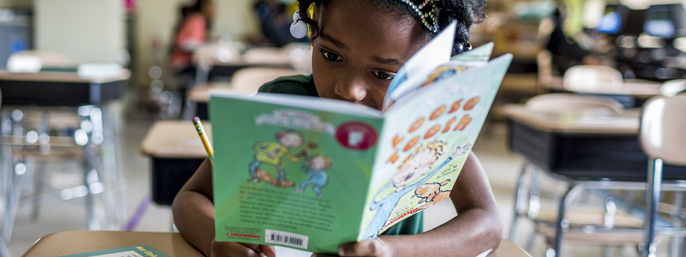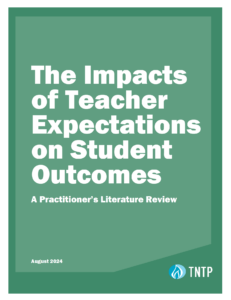Amidst the low buzz of student discussion, five sixth graders in the back of a classroom tried to figure out how Anita, the protagonist in Before We Were Free, by Julia Alvarez, felt in one particular chapter. Their classmates were gathered in similar clusters around the room, while their teacher walked from group to group, listening, asking questions and observing her students in discussion.
“Why do you think that?” asked one sixth grader, challenging a classmate who believed Anita was scared.
Flipping through the pages, the boy stopped and pointed to a paragraph. “From this conversation, you can tell.”
I perched on a milk crate and listened in on these discussions during the observation component of a recent Common Core Quality Review (CCQR), a new TNTP project to assess the current state of Common Core implementation in a district and help district leaders accelerate and improve the transition process. In addition to observing lessons—in more than 1,000 classrooms to date—we collect and analyze student work samples, conduct teacher focus groups, interview principals and district leaders and analyze curriculum and assessment materials provided by the district. These diverse sources of data give our district partners much-needed information about how their Common Core strategy is playing out in classrooms. We’re learning a lot along the way, too.
The teacher I was observing in this classroom was ahead of the curve on Common Core-aligned instruction. Her students spent most of their English lesson reading and discussing a high quality, complex text: the story of a 12-year-old girl living in the Dominican Republic before the assassination of the dictator Rafael Trujillo, known as “El Jefe.” One major factor holding back students—particularly low-income students—from developing reading, writing and analysis skills is that they often don’t have enough context about the subject of a book or passage to understand it. Building content knowledge is critical to student achievement. This teacher’s lesson was a great example of how to do this.
By reading Alvarez’s text, students built knowledge of the Dominican Republic, developed an understanding of the historical time period of the novel and learned vocabulary they will encounter across a range of subjects and future texts. Their teacher also integrated a number of standards from all four literacy domains—reading, writing, speaking and listening—that helped students analyze the text.
The discussion component of the lesson allowed students to solidify their understanding and pushed them to articulate their ideas and respond to the assertions of their peers. The questions their teacher posed during the lesson required students to return to the text to find evidence to support their claims—indicating she had spent considerable time selecting them. And in contrast to the kinds of lessons most of us are used to from our own days as students—when our teachers did most of the talking—this teacher had students do the heavy lifting of talking, thinking and working through intellectually challenging questions together. By putting the onus on students to lead the work, their teacher was helping them develop the critical thinking skills they’ll need to meet new learning standards—and graduate high school prepared for college.
Pre-Common Core, a typical English lesson might focus on a non-rigorous text that most kids found easy to understand without much critical thinking or analysis. Most assignments asked questions that did not require students to analyze texts, instead asking them to recall basic information or make connections to their own lives and experiences.
A typical pre-Common Core question in this teacher’s lesson would be “Think of a time you were afraid. How does your experience compare to Anita’s?” While this might seem like a perfectly reasonable question on the surface level, it doesn’t push students enough to grapple with—or pull examples from—the text at hand. Here’s a Common Core aligned question that prompts more engagement with the text: “What evidence from the text demonstrates how Anita’s feelings change when she learns more about El Jefe? What does this tell you about the dictator?”
See the difference?
While this teacher was making progress on many of the instructional shifts required by the new standards, there were opportunities for continued improvement.
To help students develop a deeper knowledge of this historical time period, the teacher could have allowed students to draw on information gained from rich non-fiction texts—like a history text encapsulating Trujillo’s regime in the Dominican Republic. I also didn’t observe her providing feedback to students or pushing them to be precise when presenting their evidence. Both of these actions would have helped students gain a better understanding of the text. Without more scaffolding and support from the teacher, students—particularly those reading below grade level—will likely struggle to make meaning of a complex text.
Our Common Core Quality Reviews are meant to help our district partners understand the current state of Common Core implementation and identify ways to enhance their strategy so more teachers make the instructional shifts necessary to create engaging and rigorous classrooms. Ultimately, the end goal here is to develop a system where all kids are engaged with challenging work in every class, every day in every grade, so that they all get the opportunity to succeed. These instructional shifts are incredibly challenging for teachers and school leaders.
In the coming weeks, we’ll be sharing some of those challenges, as we’ve seen them play out in classrooms across the country, and the implications for states and districts transitioning to more rigorous standards. Higher standards for our students is a critical first step, but supporting teachers to change their instructional practice to meet the expectations of these standards is necessary to achieve the changes in student learning we’re all looking for.








